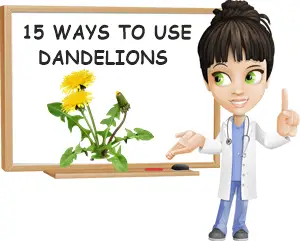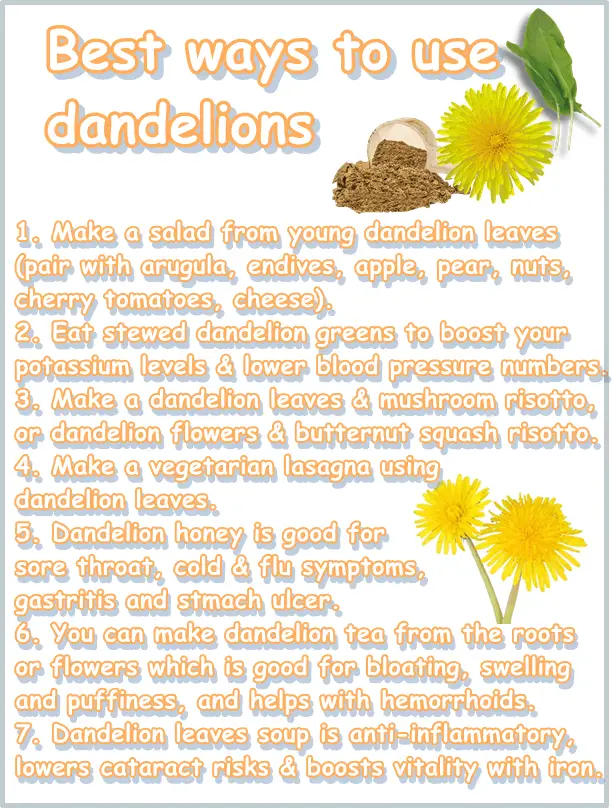Dandelions are widely regarded as weeds and so many people do whatever it takes to get rid of them. However, they do not deserve the status they’ve been given. In fact, dandelions are one of the most versatile plants there are, lending themselves to a range of culinary and therapeutic uses. Beyond their more practical uses, dandelions are an excellent ornamental plant, beyond resilient, long-lasting and vibrant. All it takes to enjoy the many benefits of dandelions is to look beyond their reputation.
How to use dandelions?
If you were given a handful of dandelions tomorrow, what would you use them for? Would you eat them? Put them in a vase? Plant them in your garden? Throw them away? Feel offended? What exactly do you do with dandelions? Most important, are dandelions good for anything?

1) Put them in a vase
Dandelions are gorgeous flowers: their vibrant yellow color and thick flower heads are a delightful sight. A field of green full of dandelions is simply breathtaking. So if you do get your hands on some dandelions, do put them in a vase and enjoy the wild beauty that they are.
2) Make dandelion coffee
The entire dandelion plant is edible, including the root. Dandelion root, botanically a taproot, can be consumed as a vegetable, or used to make dandelion coffee. Of all coffee substitutes, dandelion coffee has the best coffee taste: mildly bitter, with warm flavor notes and none of the acidity of actual coffee.
Learn more about the difference between dandelion coffee and coffee.
Just as important, dandelion coffee is full of benefits for health, with scientifically proven hepatoprotective effects for liver health, a strong prebiotic action that boosts gut health, and anticancer effects (antioxidant, anti-inflammatory and immuno-stimulating).

3) Plant them to boost soil health and thicken lawn grass
If the grass in your front and backyard is sparse and simply not looking good, then it might be time to address soil health. One of the simplest ways to improve soil quality and make your lawn look good in very little time is to introduce resilient plants that are capable of colonizing even the most difficult soils while boosting soil health.
Dandelions will break up soil that is too compacted, and draw up nutrients from deeper layers to make them available to plants that don’t grow as deep, including grass. Not just this, but they also have an anti-erosion action and nourish the grass around them. But because you don’t want your lawn to be all dandelions, do pair them with short white clover (or trefoil) to provide green coverage especially in bald places and fix nitrogen for a rich lawn grass.
4) Make a dandelion salad
It’s a known fact that dandelions are edible. But how do you eat them? If you like the taste of bitter and often eat salad, then a dandelion recipe you can try is dandelion leaves salad. Look for the youngest leaves on your dandelion plants, preferably intact (no bruising, no brown parts, no dry or tough parts). Wash well, chop or break the leaves with your hands and toss into a bowl.
Pair your dandelion leaves with various options such as sliced apples, pears or pomegranate seeds, almonds, walnuts, baby spinach, arugula, Belgian endives or plain lettuce, soft Brie cheese, Parmesan shavings, feta cheese or blue cheese crumbles, pink radishes, red cherry tomatoes, yellow grape tomatoes, cucumber and more of your favorite salad ingredients. Season with salt, lemon juice and healthy extravirgin olive oil.
5) Spice up a boring salad or dish
Use the bright yellow flower heads to spice up a boring dish, whether a salad or a main dish. Chop dandelion flowers and sprinkle in your salad or onto another dish. Dandelion flowers are rich in provitamin A carotenoids, that is, pigmented antioxidants with vitamin A activity. The flowers are also high in other antioxidants and bioactive components with therapeutic effects.
To make sure you absorb all the provitamin A in dandelion flowers, remember to eat them with a source of fat. Any source of fat will do, including extravirgin olive oil or another healthy, preferably cold pressed cooking oil you may add to your salad, or the fat from cheese, butter, milk, yogurt, egg yolk, fish or meat.
6) Make dandelion greens a side dish
You can eat dandelion leaves both raw and cooked, depending on your preferences. Cooked dandelion greens make a great side dish, pleasantly bitter and extremely nutritious. In terms of nutritional value, dandelion greens are as healthy as some of the most nutritious greens, and a great replacement.
Cooked dandelion greens have close to 200 mg of calcium per 100 grams, over 15% of daily calcium values for an adult. But one of their biggest benefits is their high potassium content of over 400 mg of potassium per 100 grams of cooked leaves, roughly 8.8% of total daily potassium values for an adult.
If you have high blood pressure, then cooked dandelion leaves are one of the best foods you can eat to lower your blood pressure numbers naturally.
Read my article on the potassium content of foods and discover how much of your daily potassium you get from eating common foods from apples, avocado and oranges to orange juice, milk, tuna, spinach and broccoli.
7) Dandelion leaves and flowers risotto
Incorporate dandelion leaves and flowers into your risotto for an exquisite recipe, full of color. Pair your dandelion leaves with brown cremini or portobello mushrooms, or porcini, and top your risotto generously with Parmesan shavings and dandelion flower petals.
If you don’t like to taste bitter, make a pumpkin or butternut squash and dandelion flowers. Add high-fat butter or extravirgin olive oil and grated Parmesan or cheddar for extra flavor and a rich, creamy consistency.
8) Dandelion vegetarian lasagna
You can use dandelion leaves to make a savory and unique vegetarian lasagna. Make your bechamel sauce as you normally would (butter, milk, flour). Cook your dandelion greens: stir fry chopped onions until golden, add the greens and cook until done. You can also use tomato sauce, garlic and your favorite herbs. Boil your lasagna pieces (or not).
In an oven safe dish, assemble everything: coat the bottom of the dish with bechamel sauce, add a layer of greens, then add a layer of lasagna. Top the lasagna with greens, add lots of grated Parmesan, or ricotta cheese, and then bechamel sauce. Repeat. Your vegetarian dandelion greens lasagna will taste phenomenal.
9) Stuffed dandelion leaves
Turn dandelion leaves into savory stuffed rolls, filled with all of your favorite ingredients. You can make them vegetarian, vegan or meat-based. Choose large leaves and blanch them to cut down on the bitter taste. Depending on the size of your leaves, you may need to use just one leaf, or stack 2 or 3 together. Fill with your favorite ingredients.
For meatless rolls, you can use a filling made from boiled rice, stir fried onions, garlic, tomato sauce and vegetables such as zucchini, eggplant etc. For sweet rolls, also vegetarian, make a filling from boiled rice, dried plums (prunes) or raisins. For non-vegetarian rolls, make a filling from ground meat stir fried with onion, garlic, tomato sauce and your favorite herbs and spices.
Roll the dandelion leaves, line them up in a deep pot, with tomato sauce between the layers. For non-vegetarian options, you can also add cold cuts (ham, bresaola, sausage, smoked prosciutto or prosciutto crudo, jamon etc.). Fill with water and cook until done. Serve with Greek yogurt or creamy sour cream.
10) Dandelion flowers honey
Bees can make honey from any flower, including dandelions. Dandelion honey is a special variety of honey, full of benefits for health. It’s antibacterial, good for stomach issues such as gastritis and ulcers, and contains pollen with immuno-stimulating properties.
However, if you are allergic to daisies, sunflowers, tarragon, safflower, chamomile, Jerusalem artichoke, globe artichoke, yarrow, marigold or chicories, all Asteraceae plants, avoid dandelion honey and flowers as well.
11) Dandelion flowers syrup
Sugary syrups are not the healthiest thing you can eat, but a little dandelion flower syrup won’t break your health. You can make dandelion flowers syrup yourself at home using any plain syrup recipe, or buy it. You can use it to sweeten your tea or coffee, or to top pancakes along with dandelion flower petals.
12) Dandelion flowers jelly or jam
If you like sweet, then a dandelion jelly or jam is the right up your alley. Pick your dandelion flowers from a pristine area (e.g. the forest or a non-agricultural field), wash them well and dry. Proceed to make jelly or ham using your favorite recipe, and enjoy on toast or on top of pancakes in the morning. You can also pair your dandelion jam with ginger or peppermint for an interesting flavor twist, or add safflower for a brighter color.
13) Make dandelion tea
Dandelion is an excellent medicinal plant with intense therapeutic activity. One of the best ways to use it is to make tea from the flowers, or root. Both dandelion flowers and root tea have diuretic effects and a strong hepatoprotective action. The tea can be consumed for high blood pressure, and helps combat water retention and associated bloating, swelling and puffiness.
Dandelion tea has a cleansing action, and studies show it helps lower LDL cholesterol levels. Dandelion tea, especially the flower tea, can be used in a sitz bath to calm hemorrhoids and reduce swelling and itching.
14) Dandelion bread
If you love home made bread and are excited to try new recipes, then dandelion flowers may just be the novelty ingredient you were looking for. Incorporate your dandelion flowers, whole or separated petals, into the bread dough right before you leave the dough to rest.
The dandelion flowers will pump your bread with antioxidants, most notably carotenoids such as carotenes, lutein and zeaxanthin with benefits for eyesight. Studies show lutein and zeaxanthin get absorbed at the level of the retina from where they enhance the antioxidant defense system, reducing risks of age related macular degeneration and even cataract. You can also add the flower petals to cookies, fritters, beignets or doughnuts.
15) Dandelion soup
Greens soups and broth are old-school detox recipes that anyone can make. A vegetarian dandelion greens soup or broth is both a depurative meal, and provides great nutrition. High amounts of vitamin K with anti-inflammatory effects, potassium and calcium for better blood pressure numbers, provitamin A carotenes and lutein and zeaxanthin for lower cataract risks and good amounts of iron for vitality and higher energy levels are just some of the benefits you will enjoy if you eat dandelion leaves soup.
